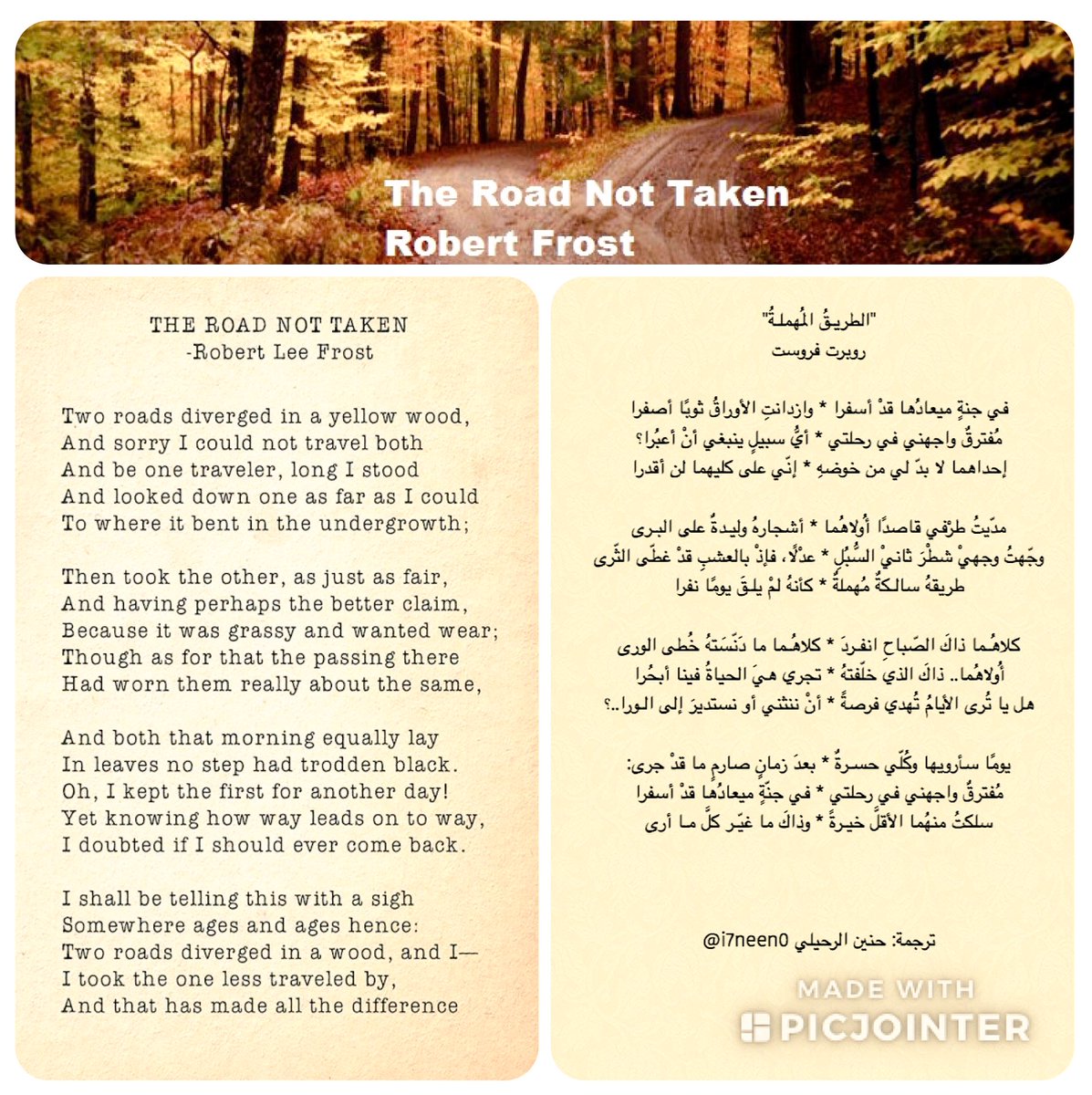

" The poem’s speaker tells us he 'shall be telling,' at some point in the future, of how he took the road less traveled…yet he has already admitted that the two paths 'equally lay / In leaves' and 'the passing there / Had worn them really about the same.' So the road he will later call less traveled is actually the road equally traveled. A critique in The Paris Review by David Orr described the misunderstanding this way: Actually, it expresses some irony regarding such an idea. Yet, it is a frequently misunderstood poem, often read simply as a poem that champions the idea of "following your own path". "The Road Not Taken" is one of Frost's most popular works. In one of the few lines containing strictly iambs, the more regular rhythm supports the idea of a turning towards an acceptance of a kind of reality: "Though as for that the passing there … " In the final line, the way the rhyme and rhythm work together is significantly different, and catches the reader off guard. The variation of its rhythm gives naturalness, a feeling of thought occurring spontaneously, affecting the reader's sense of expectation.

"The Road Not Taken" reads naturally or conversationally, beginning as a kind of photographic depiction of a quiet moment in yellow woods. The meter is basically iambic tetrameter, with each line having four two-syllable feet, though in almost every line, in different positions, an iamb is replaced with an anapest. With the rhyme scheme as 'ABAAB', the first line rhymes with the third and fourth, and the second line rhymes with the fifth. The poem consists of four stanzas of five lines each. Thomas was killed two years later in the Battle of Arras. Thomas took the poem seriously and personally, and it may have been significant in Thomas' decision to enlist in World War I. After Frost returned to New Hampshire in 1915, he sent Thomas an advance copy of "The Road Not Taken". Thomas was indecisive about which road to take, and in retrospect often lamented that they should have taken the other one. One day, as they were walking together, they came across two roads. Thomas and Frost became close friends and took many walks together. If Frost’s most famous poem is representative, and if Orr is right about it, we should see Frost not as the earnest Yankee sage beloved by junior high school teachers or the dark jokester expounded by college professors, but as an artist able to evoke and clarify the conflicts that follow from the ways we think we understand ourselves.Frost spent the years 1912 to 1915 in England, where among his acquaintances was the writer Edward Thomas. This holds for the poet as well as the poem. Orr - who writes the On Poetry column for the Book Review - is the first person to argue this at length for a popular audience, and he’s persuasive enough to give us good reason to hope that his interpretation will lodge a toehold in conventional wisdom. The options “blur and merge,” Orr writes they are “like overlapping ghosts.” As he evocatively puts it, “Two potential poems revolve around each other, separating and overlapping like clouds in a way that leaves neither reading perfectly visible.” It might have changed him deeply, it might not have. His decision might have been arbitrary, it might have been meaningful. It doesn’t accept or reject its myth of choice but sets us up to feel the tensions involved in having to choose, as if each reader were the traveler.

Yet according to the corrective that David Orr offers in “The Road Not Taken,” his new book-length analysis, the poem is neither an ode nor a dark joke but somehow both at once. It was an arbitrary choice, this national myth of choosing independently and bravely and becoming the sum of your choices or finding yourself. The other looked as grassy, as trodden, as easy or hard or distinctive. The traveler hasn’t been changed by his choice of a long and lonely road, but tells us that he’s going to tell that story when he’s older, even though he had no particular reason to choose the road he took.

As interpreted in The New Yorker or “Orange Is the New Black,” the poem is not in fact an ode to individualism but a joke at the expense of individualist hokum. Most of us have also heard the story that says this is all bunk. That poem is “The Road Not Taken,” by Robert Frost, and its subject is familiar to most of us who attended an American or a Yankophilic middle school at some point in the last century: A traveler comes to a fork in the woods and, after sweating over his direction in life, takes the road less traveled, and it makes all the difference. David Orr has written the best popular explanation to date of the most popular poem in American history.


 0 kommentar(er)
0 kommentar(er)
